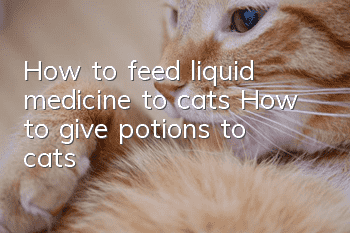How to feed liquid medicine to cats? (How to give potions to cats)

Cat medicines come in a variety of different formulations, such as tablets, capsules, pastes, and oral liquid medicines. Cats will tend to resist and struggle when you force medication into their mouths, just as they will invariably resist injectable administration. However, by following the preparation and instructions in this article, you can easily give your cat a liquid solution.
1. Prepare the required materials
1. Lay out a towel
Lay a large, clean towel over the area where you plan to administer the medication. Unless your cat is very gentle, you'll want to wrap your cat in a towel to keep it calm and prevent it from getting scratched. A standard size beach towel or bath towel is just the right size. Unfold the towel completely so that it is completely flat. Work at a comfortable and convenient height, such as on desks and counter tops.
2. Prepare medicine
Follow the directions on the bottle or your veterinarian's orders to prepare medications correctly. Many liquid medications require the bottle to be shaken before administration. If you are giving the medication directly from the vial, place it on a flat surface near where you will give the medication, such as next to a towel.
3. Prepare the dropper
If administration via a dropper or syringe is required, use the syringe or dropper to inhale the prescribed dose. Follow the instructions and measure the dosage carefully. Place the dropper or syringe close to the site of administration.
2. Prepare the cat
4. Put the cat away
Gently place the cat on the administration site (e.g. on a towel) and make sure your voice sounds happy, relaxed, and comforting to the cat. Place your cat in the center of the towel, facing you.
5. Fix the cat
At this point, you need to make sure the cat cannot squirm or escape during the administration.
If your cat is gentle, it can be easily immobilized. If you have an assistant to help you, ask him or her to put their hands on the cat's shoulders and gently grasp the cat's front legs. This will immobilize the cat, keep it calm, and prevent it from scratching you with its front paws.
You or your assistant can hold the cat against your chest and abdomen to stop it from moving backward or sideways.
If your cat moves around or wants to scratch you, you need to useWrap a towel around the cat to secure it. Wrap the towel tightly around the cat, with only his head sticking out of the towel. This ensures that the cat's claws are securely fixed in the towel and will not scratch anyone.
Fold half of the towel over your cat's back, then fold the other half over so your cat is wrapped in the towel. Loosen the towel slightly around your cat's neck so that his front paws are pressed against his body and are wrapped in the towel.
If you have an assistant, have him or her place his or her hands outside the towel and hold the cat's shoulders in place to hold the cat in place.
6. Open the cat’s mouth
Form an inverted "C" shape with the index finger and thumb of your left hand, and place this C shape on the cat's head. At this point, your fingertips and thumbs should be resting on either side of the mouth, with your palms resting on your cat's forehead. Use your fingertips and thumbs to slowly press inward on your cat's upper lip, past its upper cheek teeth (molars).
If you are left-handed, use your right hand to open the cat's mouth so that your left hand is free for administering the medicine. This forces your cat to open his mouth slightly to prevent him from biting his lip, and also reduces the likelihood of you being bitten.
7. Lift the cat’s head
When you open the cat's mouth, lift its head so that it is tilted up and back, facing the ceiling. You don't need to move your left hand to do this. Just turn your wrist. Tilt his head back to help lower his lower jaw, opening his mouth wider.
3. Administration
8. Give medicine
Put the syringe into the cat’s mouth. Pick up the syringe with your free hand and place the center of the open end of the syringe over your cat's lower canine (the long tooth at the front of his jaw) at an angle to his tongue. Gently and slowly press the syringe plunger and inject half a milliliter of liquid into your cat's mouth.
When you give the drug, your cat will move its tongue and try to swallow. Some cats like to lower their heads to swallow, so you can relax your wrist and let the cat swallow in the most comfortable position. End dosing. After the cat has swallowed the medicine, give it the remaining half milliliter of medicine. Repeat the process until it has taken the prescribed dose.
9. Reward your cat
While comforting the cat with words, he slowly untied the towel on it. In most cases, the cat will break free as soon as the towel is released. If it doesn't, then it's satisfied with the entire treatment. to catAfter taking the medicine, you can give it some rewards, which will reduce its resistance to the medicine and make it much easier to give it medicine next time.
4. Warm reminders
Although you can wrap a towel around your cat by yourself, it's much easier with an assistant to help you. While the assistant is wrapping the towel, you can prepare the medicine.
If you prepare the cat’s favorite food before taking the medicine, this can make the cat feel happy after taking the medicine.
Test the syringe with water beforehand to make sure it can be injected smoothly.
Do not exceed the dosage prescribed by your veterinarian.
Don’t put your fingers directly into the cat’s mouth to prevent it from biting you.
You must be patient and slow when giving medicine to your cat. If done too quickly, the cat may inhale the liquid, which can lead to pneumonia.
If your cat will be taking tablets, you will need to consult your veterinarian before crushing the tablets into a liquid. Some tablets need to be absorbed slowly to effectively utilize its active ingredients, and some tablets are wrapped in a protective coating to prevent stomach acid from corrosive digestion so that they can work in the intestines. Crushing or grinding these tablets will reduce the activity and efficacy of the drug, so do so alone.
- Is there a difference between cat paws and dog paw prints? How to tell the difference?
- Does your cat refuse to be groomed? This is very important to her!
- Why is the cat twitching?
- Can cat heart disease be cured? Blood pressure and radiographic examination of cat heart disease!
- If a kitten meows as soon as it's locked in the cage, that's because you're not doing something right.
- Can cats bask in the sun?
- What are the causes of shortness of breath in cats? Shortness of breath in cats should not be underestimated!
- Can cats eat chicken bones? Why?
- What is the problem if a cat has purulent eye droppings in its eyes? What should a poop remover do?
- How to treat cat glaucoma



